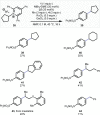Formal Cross-Coupling of Amines and Carboxylic Acids to Form sp3-sp2 Carbon-Carbon Bonds
- PMID: 37184831
- PMCID: PMC10214451
- DOI: 10.1021/jacs.2c11563
Formal Cross-Coupling of Amines and Carboxylic Acids to Form sp3-sp2 Carbon-Carbon Bonds
Abstract
Amines and carboxylic acids are abundant synthetic building blocks that are classically united to form an amide bond. To access new pockets of chemical space, we are interested in the development of amine-acid coupling reactions that complement the amide coupling. In particular, the formation of carbon-carbon bonds by formal deamination and decarboxylation would be an impactful addition to the synthesis toolbox. Here, we report a formal cross-coupling of alkyl amines and aryl carboxylic acids to form C(sp3)-C(sp2) bonds following preactivation of the amine-acid building blocks as a pyridinium salt and N-acyl-glutarimide, respectively. Under nickel-catalyzed reductive cross-coupling conditions, a diversity of simple and complex substrates are united in good to excellent yield, and numerous pharmaceuticals are successfully diversified. High-throughput experimentation was leveraged in the development of the reaction and the discovery of performance-enhancing additives such as phthalimide, RuCl3, and GaCl3. Mechanistic investigations suggest phthalimide may play a role in stabilizing productive Ni complexes rather than being involved in oxidative addition of the N-acyl-imide and that RuCl3 supports the decarbonylation event, thereby improving reaction selectivity.
Conflict of interest statement
The authors declare the following competing financial interest(s): The Cernak Lab has received research funding or in-kind donations from MilliporeSigma, Relay Therapeutics, Janssen Therapeutics, SPT Labtech, Entos, Inc. and Merck & Co., Inc. T.C. holds equity in Scorpion Therapeutics and is a co-Founder and equity holder of Entos, Inc.
Figures






References
-
- Haas D.; Hammann J. M.; Greiner R.; Knochel P. Recent Developments in Negishi Cross-Coupling Reactions. ACS Catal. 2016, 6 (3), 1540–1552. 10.1021/acscatal.5b02718. - DOI
-
- Cordovilla C.; Bartolomé C.; Martínez-Ilarduya J. M.; Espinet P. The Stille Reaction, 38 Years Later. ACS Catalysis. 2015, 5, 3040–3053. 10.1021/acscatal.5b00448. - DOI
Grants and funding
LinkOut - more resources
Full Text Sources

